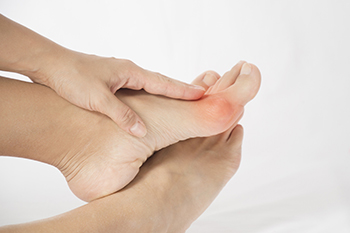
A bunion is a detrimental foot condition that can develop on the side of the big toe. Bunions can form either in response to a genetic disposition towards bunions or in response to foot injuries. Wearing narrow shoes frequently can also result in the development of bunions. Many individuals who are curious about learning more about this condition often wonder what exactly bunions look like and what their normal size is. Bunions are shaped like a bony lump, bulge, or bump. This lump is typically located at the point where the joint is located in the toe. Bunions can come in many different sizes. Regular bunions typically form on the side of the big toe. However, smaller bunions are also possible as well. For example, bunions that are smaller in size are known as bunionettes and can form on the side of the pinky or little toe. If you are interested in learning more about bunion shapes and sizes, contact a podiatrist today who will be able to help answer your questions.
If you are suffering from bunions, contact Shawn Echard, DPM of Laurel Podiatry LLC. Our practitioner can provide the care you need to keep you pain-free and on your feet.
What Is a Bunion?
A bunion is formed of swollen tissue or an enlargement of boney growth, usually located at the base joint of the toe that connects to the foot. The swelling occurs due to the bones in the big toe shifting inward, which impacts the other toes of the foot. This causes the area around the base of the big toe to become inflamed and painful.
Why Do Bunions Form?
Genetics – Susceptibility to bunions are often hereditary
Stress on the feet – Poorly fitted and uncomfortable footwear that places stress on feet, such as heels, can worsen existing bunions
How Are Bunions Diagnosed?
Doctors often perform two tests – blood tests and x-rays – when trying to diagnose bunions, especially in the early stages of development. Blood tests help determine if the foot pain is being caused by something else, such as arthritis, while x-rays provide a clear picture of your bone structure to your doctor.
How Are Bunions Treated?
- Refrain from wearing heels or similar shoes that cause discomfort
- Select wider shoes that can provide more comfort and reduce pain
- Anti-inflammatory and pain management drugs
- Orthotics or foot inserts
- Surgery
If you have any questions, please feel free to contact our offices located in Greensburg and Somerset, PA . We offer the newest diagnostic and treatment technologies for all your foot care needs.
